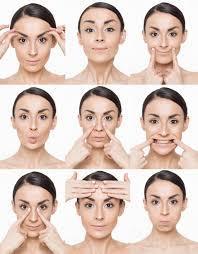Project Description

Project description
Our skin must have cared for regular cleansing keeps your skin soft, supple, and naturally nourished.
Additional products such as almond scrub, aloe vera gel, or fruit cream pack may be used depending on the type of facial. Because of the intricate nature of the facials, it is recommended that they be done every 1 to 45 days.

Now, I'm going to explain the different key points:
● What is a clean-up?
● What is facial?
● Steps to do clean-up
● Steps to do facial.
● Difference between facial and clean up
● Which is preferable, clean-up or facial?
● Tips to Remember
● Conclusion

What is clean-up?
A clean-up focuses on thoroughly washing the skin. It aids in the removal of dirt, dead skin cells, excess oil, and sebum that have accumulated on the skin's top layer. Once the skin is clean, it is easier for the moisturizer to absorb the nutrients.
Deep washing, exfoliating, steaming the face, and eliminating all whiteheads and blackheads are part of a clean-up. After this procedure, a calming gel is sometimes used.
Steps to do clean up
Maintaining a high maintenance regime for face cleaning at home is challenging. As a result, even the most slackers will struggle to find an excuse for this simple routine.
1. Cleanse your face
For this purpose, you can use a gentle soap or face wash. To remove the cleanser, use warm (not hot!) water.
Step 2: Remove dead cells.
If you simply wash your face, dead cells, blackheads, and dirt deep within the skin pores will not be removed. You must also scrub your face. There are many good scrubbing packs on the market, but you can easily make one at home.
Getting rid of blackheads is a difficult task. To learn some tried-and-true methods for removing blackheads, read our post on HOW TO REMOVE BLACKHEADS.
Step 3: Use a toner to soothe the skin.
Toner acts as a medicine, covering up any skin breakages caused by scrubbing. After scrubbing, your face may be prone to redness and burning, so apply a toner right away.

Step 4: Put on a pack
face masks and moisturizers
In addition to absorbing excess oils, Packs also close the pores that open during the cleansing and scrubbing process.
To close the pores, rinse the pack with cool water.
Step 5: Use moisturizers to hydrate.
Packs can cause your skin to appear dry and stretched. A moisturizer hydrates the skin while also sealing in the goodness of the cleanser, leaving your face glowing for a long time. Dry skin types should use oil-based creams, while oily skin types should use water-based creams.
Following this simple face cleansing routine will make your skin glow and look fresh at all times. However, if you prefer a professional hand to do the job for you without leaving the comfort of your own home, Still, if you'd rather have a professional to do this job, book a Parlor services at home to schedule a weekend face clean-up.
You can employ numerous simple tips and tricks to wake up with a BRIGHT MORNING FACE. You can read it here!
How to Make a Face Cleanser with Natural Homemade Ingredients
For dry skin, use: To make a thick paste, combine one spoon of ground almonds and two scoops of fresh yogurt.
For oily skin, use: Combine equal parts honey and lemon juice. Apply to the skin and leave it for 5 minutes. After that, wipe it down.
What is facial?
A well-done home facial will leave your skin appearing fresh, youthful, moisturized, and rejuvenated. Your skin will look and feel better and fresher. If you follow a good skin care program and have a facial once a month.
Cleaning, exfoliation, heating, deep pore extraction, massage, and a face mask or pack are all common elements of facials. Some salons are specific about their customers' preferences and may request your name and address information.
A facial is often regarded as one of the most effective treatments to hydrate and nurture your skin. With the addition of moisture, blood circulation, and essential nutrients, a facial cleanse eliminates dirt and bacteria from your skin and adds water, blood circulation, and essential nutrients.
Steps to do facial
Cleaning the face and neck area to remove any remaining product, makeup, or grime is the first step in the facial. This is usually done with a damp washcloth, cotton pad, facial sponge, and facial cleanser.
Exfoliation is another crucial step in properly cleansing the skin and removing dead skin cells for better cell renewal.
Steaming is accomplished by either laying a heated towel on the face or exposing the skin to steam. This procedure helps in the opening of pores, making it more straightforward to remove pollutants.
Extraction- People with oily skin are more likely to have clogged pores, blackheads and whiteheads, and debris on their skin. Extractions are performed by hand or with a metal device to completely clear the pores.
Massage- After completing the preceding stages, a massage is required to enhance lymphatic drainage.
Masking- A mask is put on your face based on your skin type. For oily skin, it might be clay-based, while for dry skin, it could be moisturizing.
Following that, serum or moisturizer may be applied.
Are you still undecided and want to know which option is best for you?
Don't worry. We've got it covered. Simply sit back and read the information below to determine which option is best for you and your skin.
What is the difference between Facial and Clean-up?
A Facial includes unique treatments like massage, but a clean-up does not have it.
A Facial is a bit more pricey than a clean-up.
A Facial treatment takes more time than a clean-up.
Chemical peels can be included in Facials and not cleaned up.
In addition to clean-up services like deep cleansing, exfoliation, and removal of blackheads, Facials also include moisturizers, serum, and face masks.
There is more variety of Facials available than clean-up.
Which is preferable: a facial or a clean-up
A facial could be pretty beneficial if you have major skin issues like excessive oiliness, buildup, blackheads, or even a lot of dryness. It would be more appropriate for you, and your skin would benefit. On the other hand, clean-up would be ideal if you simply want to cleanse. Another consideration is massage, which promotes blood circulation and cell renewal. So, if it appeals to you, a facial should be your personal preference from Beauty Services at home
Tips to remember!
1. Remember to tell your aesthetician.
(beautician) if you are allergic to any ingredients.
2. If you're doing it yourself, make sure you don't buy anything that can be harmful to you or create an allergic reaction.
3. Avoid harsh scrubs or ask your aesthetician not to use them. Use gentle exfoliants instead.
Conclusion
Finally, we can state that if you want a cleansing procedure for your skin, clean-up is a way to go, but a facial is a way to go if you want a proper treatment for your skin.
You don't have to be concerned about the duration of facials and clean-ups. A facial should be done every 3-4 weeks and cleaned every fortnight. You have to choose a Home Salon Services near me with a skilled professional glamcode that can advise you on the best time for your skin.
At Glamcode, we pamper you with soothing facials and makeup. These beautiful treatments will not only improve your natural beauty but will also keep imperfections at bay.
FAQs
1. What are the advantages of cleaning up?
Cleansing your skin aids in removing excess oil, dirt, and sweat. The skin is rejuvenated, moisturized, and nourished as a consequence.
2. What are the risks of having a facial?
Skin irritation and redness are common adverse effects of a facial. It could be a result of certain chemicals or harsh exfoliants. It can also occur due to pressure applied during extraction and exfoliation.
3. Can you get a facial every week?
It is unnecessary to have a facial every week; once a month is aplenty. Maintain a healthy diet and skincare routine as well.
4. Do facials aid in the removal of blackheads?
Yes, facials can assist in the removal of blackheads.
